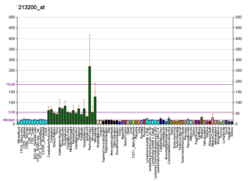Top Qs
Timeline
Chat
Perspective
Synaptophysin
Protein-coding gene in the species Homo sapiens From Wikipedia, the free encyclopedia
Remove ads
Synaptophysin, also known as the major synaptic vesicle protein p38, is a protein that in humans is encoded by the SYP gene.[5][6]
Remove ads
Gene
The gene is located on the short arm of X chromosome (Xp11.23-p11.22). It is 12,406 bases in length and lies on the minus strand.
Tissue distribution
It is expressed in neuroendocrine cells and in virtually all neurons in the brain and spinal cord that participate in synaptic transmission.
Structure
The protein is a synaptic vesicle glycoprotein with four transmembrane domains weighing 38 kDa.
Function
The exact function of the protein is unknown: it interacts with the essential synaptic vesicle protein synaptobrevin, but when the synaptophysin gene is experimentally inactivated in animals, they still develop and function normally.[7] Recent research has shown, however, that elimination of synaptophysin in mice creates behavioral changes such as increased exploratory behavior, impaired object novelty recognition, and reduced spatial learning.[8]
Remove ads
Clinical significance
Biomarker
It acts as a marker for neuroendocrine tumors, and its ubiquity at the synapse has led to the use of synaptophysin immunostaining for quantification of synapses.[9]
Using immunohistochemistry, synaptophysin can be demonstrated in a range of neural and neuroendocrine tissues,[10] including cells of the adrenal medulla and pancreatic islets. As a specific marker for these tissues, it can be used to identify tumours arising from them, such as neuroblastoma, retinoblastoma, phaeochromocytoma, carcinoid, small-cell carcinoma, medulloblastoma and medullary thyroid carcinoma, among others. Diagnostically, it is often used in combination with chromogranin A.[11]
X-linked intellectual disability
Mutations in this gene have been implicated in X-linked intellectual disability.[12]
Remove ads
Interactions
Synaptophysin has been shown to interact with AP1G1[13] and SIAH2.[14]
See also
- List of human genes
- Merkel-cell carcinoma - although origin of this tumor is unclear, it does express synaptophysin
References
Further reading
External links
Wikiwand - on
Seamless Wikipedia browsing. On steroids.
Remove ads





